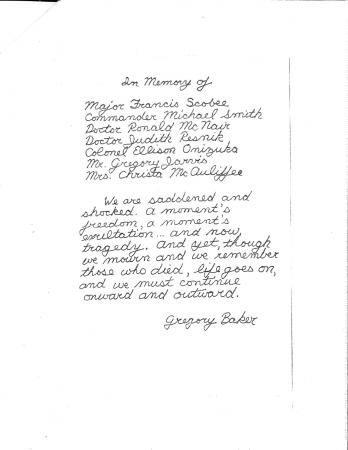When the Smithsonian National Air and Space Museum (NASM) opened on the National Mall in 1976, supporters knew it would be a place to learn, explore, and celebrate America’s technological progress. It’s not clear whether anyone considered it would become a memorial site in the face of tragedy.
On Tuesday, January 28, 1986, visitors were excited for a trip to Smithsonian’s National Air and Space Museum, and with an extra bonus. They could watch that day’s anticipated space shuttle launch on televisions in the Space Hall of the museum. But what they witnessed was disaster, when the Challenger shuttle exploded seventy-three seconds into its launch.
Within hours, tourists and local residents gathered around the shuttle exhibit to silently mourn the seven crew members—Gregory Jarvis, Christa McAuliffe, Ronald McNair, Ellison Onizuka, Judith Resnik, Francis R. Scobee, and Michael J. Smith.
The next day, NASM Director Walter Boyne, Senator John Glenn, Senator Jake Garn, and Secretary of Education William Bennett unveiled a memorial for the crew at the museum. The plaque, draped in black, included a black-and-white photograph of the crew and the individual names of the members. Visitors brought flowers and cards to the makeshift memorial, and Boyne read a poem that had been taped to the museum’s entrance by a Gregory Baker of Maryland.

The tragedy also deeply affected Smithsonian staff. NASM Public Affairs Specialist Holly Haynes noted, “People everywhere need to express their feelings, including the staff here. Many of them have worked closely with the shuttle crew.” Docents and staff wore black ribbons, and photographs of the crew appeared across the museum, from the NASM library to kiosk windows in the parking garage.
Tragedy struck again on February 1, 2003, when the shuttle Columbia disintegrated upon re-entry into Earth’s atmosphere, killing its seven crew members—Michael P. Anderson, David M. Brown, Kaplana Chawla, Laurel Clark, Rick D. Husband, William C. McCool, and Ilan Ramon.
Once again, mourners found solace in the museum, gathering near the model of the Columbia on display. On the afternoon of the accident, around one hundred visitors watched a live news briefing from NASA at the museum. And on February 4, the National Air and Space Museum televised the memorial service held in Texas. Once again, many left flowers behind. After the accident two thousand people from fifty-five countries signed the condolence book at the museum.
Soon after the tragedy, museum curators grappled with how to present disaster and the risks of space travel to visitors. NASM Curator Valerie Neal explained, “We are trying to be responsible and have the darker side of technology acknowledged.”
The result of these curatorial discussions were two exhibit cases in Moving Beyond Earth, which opened in 2009 and addressed the era of the space shuttle. The cases explored the causes and consequences of the tragedies and included memorial plaques, gifts from NASA to honor the crew members, and personal artifacts of the crew. Of the exhibit, Neal wrote, “We hope that visitors who discover these displays reflect on the reality of loss in the high-risk venture of spaceflight.”
Since the time just after the Columbia accident, museum curators discussed whether or not to display wreckage from the disaster. This came up again around the twenty-fifth anniversary of the Challenger tragedy in 2011. It is clear that considerations for the families of the lost crew members were greatly considered in the discussion. “We have gained a sense from the Columbia families,” Neal revealed, “that they would not be comfortable with anything on display while their children were young.”

Recovered hardware from the disaster was finally displayed by NASA, owner of the wreckage from the shuttles, in Forever Remembered. The astronauts’ families worked with the agency on the permanent memorial exhibit, which opened in 2015 at NASA’s Kennedy Space Center in Florida. Center Director Bob Cabana explained, “These crews and these vehicles are part of who we are as an agency, and a nation. They tell the story of our never-ending quest to explore our undying spirit to never give up.”
Related Resources
- “A Classroom Copes with the Columbia Disaster,” by Marty Kelsey, Smithsonian National Air and Space Museum
- “‘Forever Remembered,’ Shares Enduring Lessons of Challenger, Columbia,” NASA
- “Remembering Columbia, Fifteen Years Later,” by Michael D. Leinbach and Jonathan H. Ward, Smithsonian National Air and Space Museum
- “Remembering the Challenger 25 Years Later,” by Valerie Neal, Smithsonian National Air and Space Museum
- “Remembering the Challenger Tragedy,” by Megan Gambino, Smithsonian Magazine
Related Collections
- National Air and Space Museum, Office of the Director, NASM Files, Record Unit 338, Smithsonian Institution Archives
- Plaque, Memorial, Challenger STS 51-L Crew, Smithsonian National Air and Space Museum
- Plaque, Memorial, Columbia STS-107 Crew, Smithsonian National Air and Space Museum
- Space Shuttle Columbia Cockpit, Smithsonian National Air and Space Museum
Produced by the Smithsonian Institution Archives. For copyright questions, please see the Terms of Use.

Leave a Comment